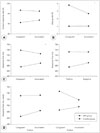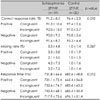Abstract
Objectives
Schizophrenia has been considered to be characterized by an abnormality in attention, especially in the executive control. Emotion is an important component of the executive control. The aim of this study was to investigate the influence of emotion on the executive control in patients with schizophrenia.
Methods
Participants were 20 healthy controls and 19 subjects with schizophrenia. They viewed full-color pictures selected from the International Affective Picture System. During each trial, an emotional picture, which was either positive or negative, lit up on either the left or right side. Participants were instructed to respond to the emotional valance of each stimulus by pressing a button with their left or right index finger, while ignoring its presented side.
Results
There was a group difference in the response time, and patients with schizophrenia exhibited an impairment in the executive control of emotional information. However, there was no difference in the response time between the emotional conditions. In the patient group, the missing rate in the positive emotional condition was correlated with the severity of social anhedonia, whereas the missing rate in the negative emotional condition was correlated with the severity of positive symptoms.
Figures and Tables
 | Fig. 1Emotional discrimination task and four conditions, the positive congruent, negative congruent, positive incongruent and negative incongruent. |
 | Fig. 2Interaction among correct response rate, missing rate and response time in different conditions. *: statistically significant p<0.05. |
 | Fig. 3Pearson correlations of the missing rate with anhedonia scores and PANSS in patients with schizophrenia *: p<0.05, †: p<0.01. PANSS : Positive and Negative Syndrome Scale. |
References
1. Heinrichs RW, Zakzanis KK. Neurocognitive deficit in schizophrenia: a quantitative review of the evidence. Neuropsychology. 1998. 12:426–445.

2. Milev P, Ho BC, Arndt S, Andreasen NC. Predictive values of neurocognition and negative symptoms on functional outcome in schizophrenia: a longitudinal first-episode study with 7-year follow-up. Am J Psychiatry. 2005. 162:495–506.

3. Green MF. What are the functional consequences of neurocognitive deficits in schizophrenia? Am J Psychiatry. 1996. 153:321–330.

4. Benedict RHB, Harris AE, Markow T, McCormick JA, Nuechterlein KH, Asarnow RF. Effects of attention training on information processing in schizophrenia. Schizophr Bull. 1994. 20:537–546.

5. McGurk S, Twamley E, Sitzer D, McHugo G, Mueser K. A meta-analysis of cognitive remediation in schizophrenia. Am J Psychiatry. 2007. 164:1791–1802.

6. Dickinson D, Tenhula W, Morris S, Brown C, Peer J, Spencer K, et al. A randomized, controlled trial of computer-assisted cognitive remediation for schizophrenia. Am J Psychiatry. 2010. 167:170–180.

7. Strauss GP, Llerena K, Gold JM. Attentional disengagement from emotional stimuli in schizophrenia. Schizophr Res. 2011. 131:219–223.

8. Sachs G, Winklbaur B, Jagsch R, Lasser I, Kryspin-Exner I, Frommann N, et al. Training of affect recognition (TAR) in schizophrenia-Impact on functional outcome. Schizophr Res. 2012. doi:10.1016/j.schres.2012.03.005.

9. Cho BH, Ku J, Jang DP, Kim S, Lee YH, Kim IY, et al. The effect of virtual reality cognitive training for attention enhancement. CyberPsychology & Behavior. 2002. 5:129–137.

10. Posner MI, Petersen SE. The attention system of the human brain. Annu Rev Neurosci. 1990. 13:25–42.

11. Urbanek C, Neuhaus AH, Opgen-Rhein C, Strathmann S, Wieseke N, Schaub R, et al. Attention network test (ANT) reveals gender-specific alterations of executive function in schizophrenia. Psychiatry Res. 2009. 168:102–109.

12. Gooding DC, Braun JG, Studer JA. Attentional network task performance in patients with schizophrenia-spectrum disorders: evidence of a specific deficit. Schizophr Res. 2006. 88:169–178.

13. Wang K, Fan J, Dong Y, Wang CQ, Lee TM, Posner MI. Selective impairment of attentional networks of orienting and executive control in schizophrenia. Schizophr Res. 2005. 78:235–241.

14. Peer JE, Rothmann TL, Penrod RD, Penn DL, Spaulding WD. Social cognitive bias and neurocognitive deficit in paranoid symptoms: evidence for an interaction effect and changes during treatment. Schizophr Res. 2004. 71:463–471.

15. Cohen AS, Leung WW, Saperstein AM, Blanchard JJ. Neuropsychological functioning and social anhedonia: results from a community high-risk study. Schizophr Res. 2006. 85:132–141.

16. Tully LM, Lincoln SH, Hooker CI. Impaired executive control of emotional information in social anhedonia. Psychiatry Res. 2012. doi:10.1016/j.psychres.2011.12.023.

17. Tallent KA, Gooding DC. Working memory and Wisconsin Card Sorting Test performance in schizotypic individuals: a replication and extension. Psychiatry Res. 1999. 89:161–170.

18. Association AP, DSM-IV. APATFo. Diagnostic and statistical manual of mental disorders: DSM-IV-TR. 2000. American Psychiatric Publishing, Inc.
19. Kay SR, Flszbein A, Opfer LA. The positive and negative syndrome scale (PANSS) for schizophrenia. Schizophr Bull. 1987. 13:261–276.

20. Chapman LJ, Chapman JP, Raulin ML. Scales for physical and social anhedonia. J Abnorm Psychol. 1976. 85:374–382.

21. Kratzmeier H, Horn R. Manual: Raven-Matrizen-Test, Standard Progressive Matrices. 1979. Weinheim, West Germany: Beltz Test.
22. Lang PJ, Bradley MM, Cuthbert BN. International affective picture system (IAPS): Technical manual and affective ratings. 1999. Gainesville, FL: The Center for Research in Psychophysiology, University of Florida.
23. Park IH, Park HJ, Chun JW, Kim EY, Kim JJ. Dysfunctional modulation of emotional interference in the medial prefrontal cortex in patients with schizophrenia. Neurosci lett. 2008. 440:119–124.

24. Linden SC, Jackson MC, Subramanian L, Wolf C, Green P, Healy D, et al. Emotion-cognition interactions in schizophrenia: Implicit and explicit effects of facial expression. Neuropsychologia. 2010. 48:997–1002.

25. Strauss GP, Herbener ES. Patterns of emotional experience in schizophrenia: Differences in emotional response to visual stimuli are associated with clinical presentation and functional outcome. Schizophr Res. 2011. 128:117–123.

26. Choi SH, Ku J, Han K, Kim E, Kim SI, Park J, et al. Deficits in eye gaze during negative social interactions in patients with schizophrenia. J nerv Ment DIS. 2010. 198:829–835.

27. Modinos G, Pettersson-Yeo W, Allen P, McGuire PK, Aleman A, Mechelli A. Multivariate pattern classification reveals differential brain activation during emotional processing in individuals with psychosis proneness. Neuroimage. 2012. 59:3033–3041.

28. Paradiso S, Johnson DL, Andreasen NC, O'Leary DS, Watkins GL, Ponto LLB, et al. Cerebral blood flow changes associated with attribution of emotional valence to pleasant, unpleasant, and neutral visual stimuli in a PET study of normal subjects. Am J Psychiatry. 1999. 156:1618–1629.

29. Kerns JG, Berenbaum H. Aberrant semantic and affective processing in people at risk for psychosis. J Abnorm Psychol. 2000. 109:728–732.

30. Hooker CI, Tully LM, Verosky SC, Fisher M, Holland C, Vinogradov S. Can I trust you? Negative affective priming influences social judgments in schizophrenia. J Abnorm Psychol. 2011. 120:98–107.





 PDF
PDF ePub
ePub Citation
Citation Print
Print





 XML Download
XML Download